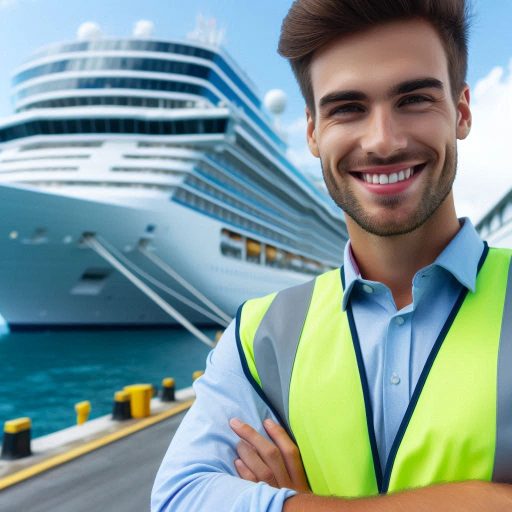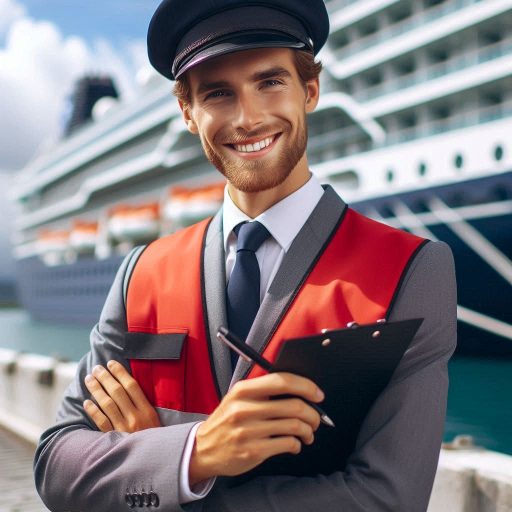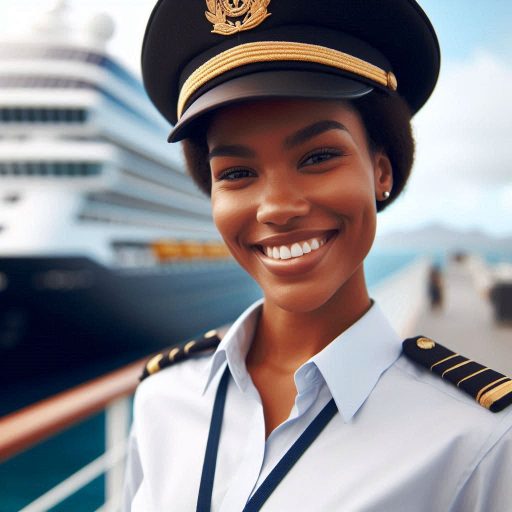Introduction
In recent years, the cruise ship industry has experienced significant growth, with millions of passengers embarking on cruises around the world.
This surge in popularity has led to an increased demand for cruise ship workers who play a crucial role in ensuring the smooth operation of these floating cities.
However, working on a cruise ship comes with its own set of unique challenges, particularly in terms of health and safety standards.
The cruise ship industry is a booming sector of the travel and tourism industry, offering passengers a luxurious and adventurous way to explore various destinations.
Cruise ships are like floating resorts, equipped with various amenities, entertainment options, dining venues, and accommodations to cater to passengers’ needs, creating an unforgettable travel experience.
Given the nature of their work, cruise ship workers are exposed to numerous occupational hazards, ranging from long working hours and physical strain to potential infectious diseases and maritime accidents.
Thus, ensuring high health and safety standards for cruise ship workers is paramount not only for their well-being but also for maintaining a safe and efficient working environment aboard these vessels.
In this blog post, we will delve into the critical role of health and safety standards for cruise ship workers, highlighting the key challenges they face and the importance of implementing robust safety measures to protect their health and well-being.
The main points to be discussed include the occupational risks faced by cruise ship workers, regulatory frameworks governing health and safety standards in the cruise ship industry, and best practices for promoting a culture of safety and wellness among crew members.
Regulations and requirements
Working on a cruise ship comes with its own set of regulations and requirements to ensure the health and safety of employees.
It’s essential for cruise ship workers to be aware of these standards and comply with them to prevent any potential risks or hazards.
Overview of international and national regulations for cruise ship workers
- International Maritime Organization (IMO) sets guidelines for safety and environmental concerns.
- Flag states enforce IMO regulations, ensuring ships meet safety standards.
- International Labour Organization (ILO) mandates working conditions for seafarers.
- National regulations vary, but generally align with international standards.
Specific health and safety standards mandated by governing bodies
- Mandatory training on safety procedures and emergency protocols for all crew members.
- Regular health screenings to monitor the well-being of employees onboard.
- Strict guidelines for handling hazardous materials and chemicals on the ship.
- Personal protective equipment (PPE) requirements to prevent injuries and accidents.
- Proper sanitation practices to maintain a hygienic environment for workers.
Importance of compliance with regulations to ensure worker safety
- Compliance with regulations reduces the risk of accidents and injuries for cruise ship workers.
- Ensures a safe working environment and promotes overall well-being of employees.
- Non-compliance can lead to fines, penalties, and legal consequences for both the cruise line and individual workers.
- By following health and safety standards, cruise ship workers can perform their duties efficiently and effectively.
In a nutshell, adherence to health and safety standards is crucial for the well-being of cruise ship workers.
It is not only a legal requirement but also a moral obligation to prioritize the safety of employees while working in the maritime industry.
By following regulations and guidelines set forth by governing bodies, cruise ship workers can ensure a safe and secure environment for themselves and their colleagues.
Read: Esthetician Career Path and Growth
Training and Certification Programs
Cruise ship workers are required to undergo specific training programs to ensure they are prepared to handle emergencies and maintain safety standards on board.
Description of Training Programs Available for Cruise Ship Workers
Training programs for cruise ship workers typically include courses on fire safety, first aid, crowd management, and evacuation procedures.
These programs are designed to equip workers with the knowledge and skills necessary to respond effectively in emergency situations.
Workers may also receive training on specific tasks related to their job duties, such as food safety for kitchen staff or pool maintenance for lifeguards.
Additionally, new employees often undergo orientation programs to familiarize themselves with the ship’s layout and emergency protocols.
Transform Your Career Today
Unlock a personalized career strategy that drives real results. Get tailored advice and a roadmap designed just for you.
Start NowImportance of Proper Training in Emergency Procedures and Safety Protocols
Proper training is crucial for cruise ship workers to ensure the safety of passengers and crew members in the event of an emergency.
Workers must be able to respond quickly and efficiently to various scenarios, including fires, medical emergencies, or evacuations.
By receiving thorough training in emergency procedures and safety protocols, workers can act confidently and decisively when faced with a crisis.
This level of preparedness can help minimize risks and prevent potential disasters from escalating.
Benefits of Certification in Different Aspects of Health and Safety
Obtaining certification in different aspects of health and safety can provide several benefits for cruise ship workers.
Certification demonstrates a worker’s commitment to maintaining high standards of safety and professionalism in their role.
Having certifications in areas such as first aid, CPR, or firefighting can also enhance a worker’s resume and increase their job prospects within the cruise industry.
Employers often prioritize candidates who hold relevant certifications, as they are more likely to have the necessary skills and knowledge to perform their duties effectively.
Furthermore, certification can lead to career advancement opportunities and higher wages for cruise ship workers.
Workers who invest in their professional development through certification programs may be eligible for promotions or specialized roles that require additional training.
Basically, training and certification programs play a critical role in ensuring the health and safety of cruise ship workers and passengers.
By equipping workers with the necessary skills and knowledge to respond to emergencies and maintain safety protocols, these programs help create a secure environment on board cruise ships.
Cruise ship workers who prioritize their training and certification can benefit from improved job prospects, career advancement opportunities, and a heightened sense of professionalism in their roles.
Read: Best Schools for Esthetician Training

Personal Protective Equipment (PPE)
Cruise ship workers face unique health and safety challenges.
Personal protective equipment (PPE) plays a crucial role in ensuring their safety.
Understanding the types of PPE required, its importance, and employer responsibilities can enhance worker protection.
Overview of Different Types of PPE Required for Cruise Ship Workers
Cruise ship workers need various types of PPE to protect against specific hazards.
Commonly required PPE includes hard hats, safety glasses, gloves, and high-visibility clothing.
Workers in food service may require non-slip shoes and hairnets.
Transform Your Career Today
Unlock a personalized career strategy that drives real results. Get tailored advice and a roadmap designed just for you.
Start NowThose in maintenance might need respiratory protection and hearing protection.
The use of proper PPE varies depending on job responsibilities and environmental conditions.
Importance of Using PPE to Minimize Risks of Injury or Illness
Using PPE significantly reduces the risks of injury or illness onboard.
It serves as the first line of defense against workplace hazards.
Hard hats protect against falling objects, while gloves prevent cuts and chemical exposure.
Safety glasses shield eyes from splashes and debris.
Effective PPE usage fosters a safer work environment, promoting overall worker well-being and productivity.
Responsibility of Cruise Ship Employers to Provide Adequate PPE
Cruise ship employers have a legal and ethical obligation to provide adequate PPE.
They must assess workplace hazards and determine necessary equipment for each role.
Employers should ensure that PPE fits properly and is well-maintained.
Additionally, they must train workers on the correct use and maintenance of PPE.
Regular inspections and replacements of damaged equipment are also essential.
By prioritizing PPE, employers contribute to a safer and healthier workplace for cruise ship workers.
All in all, effective use of PPE is vital for the safety of cruise ship workers.
Understanding different types of PPE, its importance, and employer responsibilities can significantly minimize workplace risks.
Prioritizing PPE ensures that workers remain safe and healthy while performing their duties at sea.
Read: Entertainment Staff on Cruise Ships: Job Roles
Emergency response protocols
Amidst the tranquil waters of the open sea, cruise ship workers must be prepared for any emergency that may arise.
This section will delve into the various aspects of emergency response protocols followed by cruise ship workers.
Emergency response procedures for different scenarios
- Man Overboard: Immediate alert, throw a lifebuoy, and notify the bridge.
- Fire: Alert all passengers and crew, contain the fire, and follow evacuation procedures.
- Medical Emergency: Notify the medical team, provide first aid if trained, and transfer the patient to the medical center.
- Abandon Ship: Follow muster station assignments, don life jackets, and board lifeboats in an orderly manner.
Importance of regular drills and training in emergency response
Regular drills and training are crucial for cruise ship workers to ensure they are well-prepared in the event of an emergency.
Transform Your Career Today
Unlock a personalized career strategy that drives real results. Get tailored advice and a roadmap designed just for you.
Start NowBy practicing emergency response procedures regularly, crew members can familiarize themselves with the protocols and react swiftly and effectively when faced with a crisis.
Training sessions should cover a wide range of scenarios, from fires to medical emergencies, to man overboard situations.
By simulating these scenarios in drills, cruise ship workers can hone their skills and build confidence in their ability to handle emergencies.
Furthermore, conducting regular drills allows crew members to identify areas for improvement in the emergency response procedures.
This feedback can be invaluable in refining protocols and ensuring that all crew members are well-equipped to handle any situation that may arise during a cruise.
Collaboration with other crew members in emergency situations
In an emergency situation, collaboration among cruise ship workers is essential to ensure the safety and well-being of passengers and crew members.
Communication is key, and crew members must work together seamlessly to coordinate their efforts and respond effectively to the crisis at hand.
Each crew member has a specific role to play in an emergency, whether it’s leading passenger evacuation, containing a fire, or providing medical assistance.
By working together and supporting one another, cruise ship workers can maximize their effectiveness in responding to emergencies and ensuring the safety of everyone on board.
By following the established emergency response protocols, participating in regular drills and training, and collaborating with fellow crew members, cruise ship workers can uphold the highest health and safety standards to protect passengers and themselves while at sea.
Read: Top Skills Needed for Estheticians
Gain More Insights: Essential Skills for Bank Tellers
Wellness Programs and Healthcare Services
Working on a cruise ship can be physically and mentally demanding, which is why it is essential for cruise ship workers to have access to wellness programs and healthcare services to maintain their well-being while at sea.
Description of Wellness Programs Offered to Cruise Ship Workers
- Many cruise lines offer wellness programs that include fitness classes, healthy meal options, and mental health resources.
- These programs are designed to support the overall health and well-being of cruise ship employees.
- Wellness programs often include access to gyms, nutritionists, and counseling services for stress management.
Importance of Access to Healthcare Services While at Sea
- Access to healthcare services while at sea is crucial for addressing any medical issues that may arise during a cruise.
- Having a medical team on board can provide immediate care for injuries, illnesses, or emergencies.
- Healthcare services also ensure that cruise ship workers receive the necessary medications and treatments for any health conditions.
Strategies for Maintaining Physical and Mental Health While Working on a Cruise Ship
- It is important for cruise ship workers to prioritize self-care by getting enough rest, eating well, and staying active.
- Creating a work-life balance and participating in stress-relief activities can help prevent burnout and improve mental health.
- Seeking support from coworkers, supervisors, or mental health professionals can also contribute to overall well-being while working on a cruise ship.
Overall, access to wellness programs and healthcare services plays a significant role in ensuring the health and safety of cruise ship workers.
By utilizing these resources and implementing strategies for maintaining physical and mental health, employees can thrive in their roles and enjoy a fulfilling experience while at sea.
Find Out More: Managing Jet Lag as a Flight Attendant
You Might Also Like: Key Traits of Successful Front Desk Agents
Safety Culture on Board
Fostering a strong safety culture among cruise ship workers is paramount to ensuring the well-being of all crew members and passengers.
This culture sets the tone for how seriously health and safety are taken on board and influences the behavior and attitudes of all individuals on the ship.
Importance of Fostering a Culture of Safety Among Crew Members
The importance of fostering a culture of safety among crew members cannot be overstated.
Transform Your Career Today
Unlock a personalized career strategy that drives real results. Get tailored advice and a roadmap designed just for you.
Start NowWhen safety is placed as a top priority, it creates an environment where everyone feels responsible for the well-being of themselves and others.
This sense of shared responsibility leads to heightened awareness, vigilance, and adherence to safety protocols.
As a result, accidents and incidents are minimized, and the overall safety of the ship is significantly improved.
Ways to Promote Accountability and Responsibility for Health and Safety
There are several ways to promote accountability and responsibility for health and safety among cruise ship workers.
One effective method is through comprehensive training programs that educate crew members about safety protocols, emergency procedures, and best practices for accident prevention.
Clear communication of expectations, standards, and consequences for non-compliance also helps reinforce the importance of safety.
Additionally, assigning specific roles and responsibilities related to health and safety can help ensure that everyone knows their part in maintaining a safe environment on board.
Regular drills, inspections, and evaluations can further reinforce the culture of safety and hold individuals accountable for their actions.
Encouraging Open Communication and Reporting of Safety Concerns
Open communication and reporting of safety concerns are essential components of a strong safety culture on board a cruise ship.
Crew members should feel empowered to speak up about any potential hazards, risks, or safety violations they observe without fear of retribution or judgment.
To encourage this open communication, it is important to establish clear channels for reporting safety concerns, such as anonymous reporting systems, suggestion boxes, or designated safety officers.
Regular safety meetings, feedback sessions, and debriefings can also provide opportunities for crew members to voice their concerns and contribute to continuous improvement in safety practices.
By fostering an environment of trust and transparency, cruise ship operators can proactively address safety issues before they escalate into serious incidents.
Learn More: Managing Difficult Customers as a Front Desk Agent
Conclusion
It is crucial for cruise ship companies to prioritize the health and safety standards for their workers.
This is essential in ensuring a safe and secure environment for all employees on board.
We have highlighted the importance of implementing proper training programs, providing necessary safety equipment, conducting regular inspections, and fostering a culture of safety among crew members.
By prioritizing health and safety standards, cruise ship companies can prevent accidents, reduce injuries, and improve overall employee satisfaction.
This not only benefits the workers but also enhances the reputation of the company.
We urge all cruise ship companies to invest more in health and safety measures for their workers.
Transform Your Career Today
Unlock a personalized career strategy that drives real results. Get tailored advice and a roadmap designed just for you.
Start NowThis includes ongoing training, regular equipment maintenance, and open communication channels for reporting any safety concerns.
Together, we can create a safer working environment for all cruise ship employees.
[E-Books for Sale]
The Big Book of 500 High-Paying Jobs in America: Unlock Your Earning Potential
$19.99 • 500 High-Paying Jobs • 330 pages
Explore 500 high-paying jobs in America and learn how to boost your career, earn more, and achieve success!
See All 500 High-Paying Jobs of this E-Book
1001 Professions Without a Degree: High-Paying American Jobs You Can Start Now
$19.99 • 1001 Professions Without a Degree • 174 pages
Discover 1001 high-paying jobs without a degree! Unlock career tips, skills, and success strategies for just $19.99!




